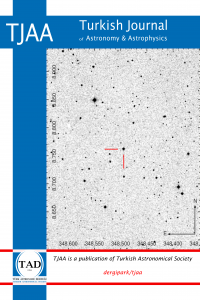Kepler Uzay Teleskobu ve ASAS Görüş Alanındaki Sefeid Türü Değişen Yıldızların Frekans Analizi
techniques: photometric, methods: data analysis, individual: KIC6269092, KIC7899428, stars: variables: Cepheids
Frequency Analysis of Cepheid Type Variable Stars in Kepler Space Telescope and ASAS FoV
techniques: photometric, methods: data analysis, individual: KIC6269092, KIC7899428, stars: variables: Cepheids,
___
- Akerlof C., et al., 2000, The Astronomical Journal, 119, 1901
- Antonello E., Broglia P., Conconi P., Mantegazza L., 1986, A&A, 169, 122, ADS
- Blomme J., et al., 2010, The Astrophysical Journal Letters, 713, L204
- Borucki W. J., et al., 2010, Science, 327, 977
- Brown T. M., Latham D. W., Everett M. E., Esquerdo G. A., 2011, The Astronomical Journal, 142, 112
- Davenport J. R., 2016, The Astrophysical Journal, 829, 23
- Deb S., Singh H. P., 2009, Astronomy & Astrophysics, 507, 1729
- Debosscher J., Sarro L., Aerts C., Cuypers J., Vandenbussche B., Garrido R., Solano E., 2007, Astronomy & astrophysics, 475, 1159
- Everett M. E., Howell S. B., Kinemuchi K., 2012, Publications of the Astronomical Society of the Pacific, 124, 316
- Farmer R., Kolb U., Norton A., 2013, Monthly Notices of the Royal Astronomical Society, 433, 1133
- García R., et al., 2005, Astronomy & Astrophysics, 442, 385
- García R., et al., 2011, Monthly Notices of the Royal Astronomical Society: Letters, 414, L6
- Gilliland R. L., et al., 2010a, Publications of the Astronomical Society of the Pacific, 122, 131
- Gilliland R. L., et al., 2010b, The Astrophysical Journal Letters, 713, L160
- Haas M. R., et al., 2010, The Astrophysical Journal Letters, 713, L115
- Hendry M. A., Tanvir N. R., Kanbur S. M., 1999, in Egret D., Heck A., eds, Astronomical Society of the Pacific Conference Series Vol. 167, Harmonizing Cosmic Distance Scales in a Post- HIPPARCOS Era. pp 192–197
- Jin H., Kim S.-L., Lee C.-U., Lee D.-J., Kim K.-S., 2004, The Astronomical Journal, 128, 1847
- Joshi Y. C., Joshi S., 2014, New Astron., 28, 27
- Kinemuchi K., Barclay T., Fanelli M., Pepper J., Still M., Howell S. B., 2012, Publications of the Astronomical Society of the Pacific, 124, 963
- Koch D. G., et al., 2010, The Astrophysical Journal Letters, 713, L79
- Yayın Aralığı: Yılda 2 Sayı
- Başlangıç: 2020
- Yayıncı: Türk Astronomi Derneği
NGC 6811 Kümesindeki Evrimleşmiş Yıldızların Küçük Ayrılmalarının İncelenmesi
Yıldızlarda Neler Oluyor? Kırmızı Budak Yıldızların Evrimine İlişkin Çıkarımlar
Magnetarların Parlama Sırasındaki Gürültü Genlikleri
Danjela SERİM, Muhammed Mirac SERİM
OPEA Modeli ile Güneş Aktivitesinde X-ışın Flare Davranışının Belirlenmesi
Güneş Civarındaki Anakol Yıldızlarının Işıma Gücü Fonksiyonunun Gaia Verileriyle Belirlenmesi
Doğu Deniz BULUT, Sabiha TUNÇEL GÜÇTEKİN
Kimyasal Sıra Dışı Yıldızların Element Bolluklarını Araştırmak İçin Yeni Bir Yaklaşım
Kepler Uzay Teleskobu ve ASAS Görüş Alanındaki Sefeid Türü Değişen Yıldızların Frekans Analizi
Mehmet Oğuzhan ERTURAN, Hasan AK
Güney Galaktik Diskin Milimetre Dalgaboyunda Haritalandırılması
Kerem Osman ÇUBUK, M. G. BURTON, Catherine BRAİDİNG, G. F. WONG, Gavin ROWELL, N. F. H. TOTHİLL
Yıldız İç Yapı Modelleri için Yüzey Yama Modelleri
